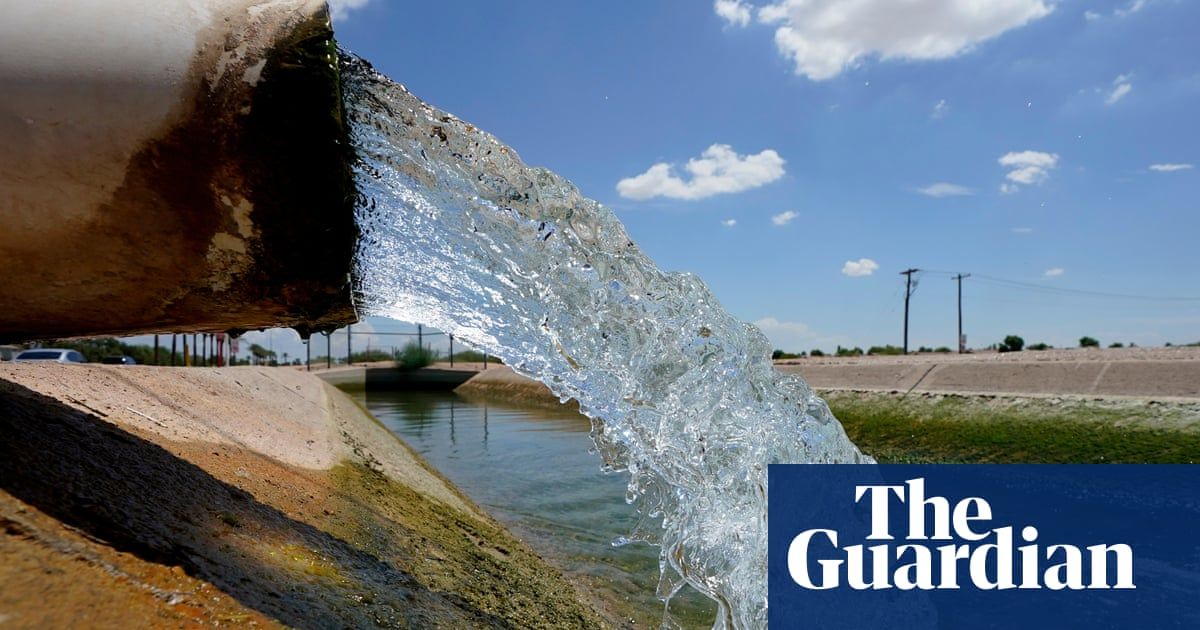US states agree breakthrough deal to prevent Colorado River from drying up
A deal has been struck by Joe Biden’s administration for California, Arizona and Nevada to take less water from the drought-stricken Colorado River, in a bid to prevent the river dwindling further and imperiling the water supplies for millions of people and vast swaths of agricultural land in the US west.
The agreement, announced on Monday, will involve the three states, water districts, Native American tribes and farm operators cutting about 13% of the total water use in the lower Colorado basin, a historic reduction that will probably trigger significant water restrictions on the region’s residents and farmland.
In all, 3m acre-feet of water is expected to be conserved over the next three years – an acre-foot is 326,000 gallons, or enough water to cover an acre of land, about the size of a football field, one foot deep. A single acre-foot is enough to sustain two average California households for a year.
Of these savings, 2.3m acre-feet will be compensated by the federal government, with $1.2bn going to cities, tribes and water districts. The rest of the savings will be voluntary, uncompensated ones to be worked out between the states.
The agreement averts, for now, the prospect of the Biden administration imposing unilateral water cuts upon the seven states – California, Arizona, Nevada, Colorado, New Mexico, Utah and Wyoming – that rely upon the river, a prospect that has loomed since last summer when the waterway’s two main reservoirs, Lake Mead and Lake Powell, hit perilously low levels.
“Today’s announcement is a testament to the Biden-Harris administration’s commitment to working with states, tribes and communities throughout the west to find consensus solutions in the face of climate change and sustained drought,” said Deb Haaland, the US interior secretary.
Governors in California, Arizona and Nevada released a statement in which they hailed the breakthrough. “The lower basin plan is the product of months of tireless work by our water managers to develop an agreement that stabilizes the Colorado River system through 2026,” said Arizona’s governor, Katie Hobbs.
Experts welcomed the deal but cautioned that a longer-term solution was still badly needed. “The fact that the lower basin states and federal government came to an agreement is encouraging – it’s a significant step forward,” said Sharon Megdal, a water policy expert at the University of Arizona.
“Lots of people will say 3m acre-feet isn’t enough, but this is about stopping the system from immediately crashing. Hopefully this will get us through the next few years and we can focus on what happens after 2026, because we were all worried how we would get there. Now there’s the hard work of getting a longer-term solution because this is by no means the end of the story.”
Harnessing the might of the Colorado river, which rises in the Rocky Mountains and flows all the way to Mexico, has enabled cities such as Los Angeles, Phoenix and Las Vegas to flourish, as well as allowing millions of acres of agricultural land to be cultivated in otherwise harsh desert environments. More than 40 million people rely on the water the 1,450-mile (2,300km) river provides.
But the enormous extraction of water, mainly for farming, coupled with the climate crisis, which has increased the evaporation of water and reduced the snowpack that feeds the river, has caused a crisis point for the river and the US west. The region is experiencing its worst drought in 1,200 years, with this year’s bumper rain and snowfall not expected to fully release the grip of a two-decade “megadrought”.
Without a deal, it was feared that the water levels at Lake Mead and Lake Powell would fall so much that the hydroelectric turbines they powered would fail, risking the power supply to millions of people.
Any further drop – Lake Mead is only about a third full and is at its lowest ebb since the construction of the Hoover dam, which created it – could see the drying up of the Colorado River south of the reservoir, which feeds the lower basin states: Nevada, California and Arizona.
Source: The Guardian US


